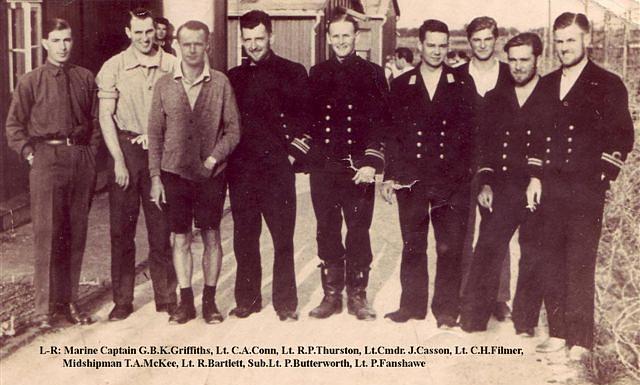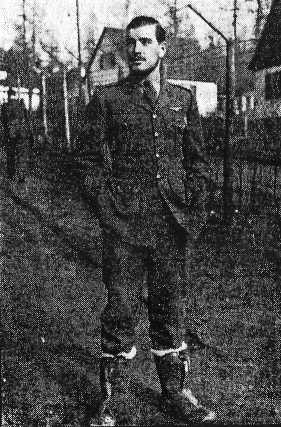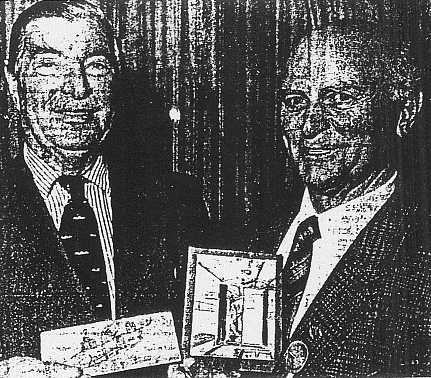Dinger's Aviation Pages
The Amazing Escape of Guy "Griff" Griffiths.
At the outbreak of the Second World War, Lieutenant Guy "Griff" Griffiths was an officer in the Royal Marines attached on flying duties as a pilot with the Air Branch of the Royal Navy¹, flying Blackburn Skua fighter/dive-bombers from the British aircraft carrier HMS Ark Royal. On only the 11th day of Britain's involvement in the War (14th September 1939) Guy was captured and taken on board the German submarine U-30 after going to the aid of the SS Fanad Head.
On their way to Germany as captives, Griffiths, along with Lt Thurston the other pilot captured in the Fanad Head incident, were well treated by the U-boat Captain, Fritz Lemp. However, when they arrived at Wilhelmshaven in Germany the Gestapo arrived onboard just as Lemp was toasting their departure. They rounded on Lemp for drinking with the enemy! With no facilities at the navy base for dealing with prisoners of war, the two British captives were at first taken to the Headquarter buildings. While they were waiting for instructions on what to do with the prisoners their guards locked them in the first available room without windows. Within a few minutes, a panic-stricken German returned to remove them from the room. - It had contained a huge wall map showing the position of all German U-boats!
Initially, Griffiths, along with Lt Thurston the other pilot captured in the Fanad Head incident, were not put into a normal prisoner of war camp. Because it was feared they knew the secret of the sinking of the liner SS Athenia by the U-30 they were put into a "political camp" with high ranking Polish officers and the Red Cross was not informed of their capture. They were not allowed to try to write to their family and friends. Apparently, an RAF bomber was shot down nearby and it's captured crew were held in the camp briefly for convenience. Griffiths "borrowed" one of the letter cards given to these prisoners and sent a cryptic message to his girlfriend (later his wife) "I am well, the weather is wet... etc). She recognised his handwriting and the matter was raised with the International Red Cross, who got Griffiths and Thurston recognised as proper POWs.

Pictured in Dalag Luft 1 in 1940 together with other Navy pilots, including Lt Thurston who was also captured in the Fanad Head incident. Guy Griffiths is on the left in the smart Royal Marines uniform (minus jacket) he was wearing when captured. Second from the right is Peter Butterworth, ² later to achieve fame as an actor, being particularly remembered for his apperances in "Carry On" films. Photo is from Cecil Filmer via Oyvind Lamo.
Griffiths was in eight different prisoner of war camps including Dalag Luft, Oflag IX-A (Spangenberg Castle), Stalag Luft 1, 2 & 3 during his captivity and was involved in numerous escape attempts. In one from Dalag Luft in June 1941, he got clear of the camp but was recaptured. In Stalag Luft 3 he was involved with the famous "wooden horse" escape. A talented artist and cartoonist, Griffiths managed to scrounge some paints and passed the time painting pictures of aircraft from his memory, although he was careful not to give any details that would be helpful to the Germans, he made up some imaginary designs to keep them guessing! His skill as an artist came in handy helping to forge documents to help in escapes. Then, in the final months of the War, with Allied armies closing in on all sides, Griffiths found himself on a forced march south towards Austria. Passing through a small German town Griffiths escaped by simply dropping out of the ragged marching column and with considerable daring, walking straight into a canteen for German soldiers and queuing up for food! Now, this may sound highly improbable, but you have to remember that when he had been shot down Griffiths had been dressed in full Royal Marine uniform. This is "lovat" green, quite unlike the Khaki uniforms of the British army. With the town full of the remnants of different Axis forces in all types of uniform it is less surprising that he was not challenged.

Guy Griffiths photographed in POW camp. His smart dark green Royal Marines uniform was completely different from the khaki battledress of the British Army. It was very similar to the uniform worn by officers in the Hungarian military (Hungary was an ally of Germany for most of WW2). Being one of the earliest British prisoners of war Griffiths was photographed several times by the German authorities in an attempt to show they were treating POWs well. Notice his flying boots.
Sitting eating his meal alone, his apparent loneliness was noticed by a group of Germans who invited him to their table, offering him a drink, which he gladly accepted. Griffiths knew a little German. The senior German officer pointed out that his Hungarian³ was as bad as his (Griffith's) German. Thus Griffiths learnt what nationality they thought he was and they agreed to continue the conversation in halting German. Together they toasted "Ultimate Victory". Believing it was best to continue to "hide in plain sight" and await the arrival of the Allies, Griffiths stayed in the town, eating in the canteen at mealtimes. The Germans noticed that this Hungarian officer seemed to have little to do, so the Chief of Police of the town approached him with a proposal. The town had a succession of POWs being marched through it, coming from camps all over Germany. Like Griffiths, many were taking the opportunity to escape by slipping away into the surrounding woods and countryside but were then picked up by German patrols. Would the Hungarian officer take responsibility for these recaptured men? Interrogate them and then deal with them as he saw fit? Griffiths replied that as a "Hungarian" he had no authority in Germany. "Not a problem." was the reply, the Chief of Police gave him written authority, counter-signed by the Burgomeister. Griffiths was allocated an office and over the next few days, a succession of escaped American prisoners were bought in via the front door, only to be fed, rested, updated on their location in Germany and then be sent to freedom out the back door! The Germans were suspicious that this ruthless Hungarian officer was executing the prisoners!
When it became clear that Allied forces was getting close Griffiths slipped away from the town and joined up with an American army unit. With his experience as a Royal Marines officer before he had been a pilot and his ability to speak German he was a valuable asset, joining in the fighting and negotiating the surrender of German units. The advance was rapid and it was pointed out to him that unless he was in captivity when they overran the next prison-camp it might be difficult to explain his position and delay his repatriation. However, when he and some other British escaped POWs presented themselves at the next POW camp the Germans flatly refused them entrance unless they had written authority. So the escaped POWs found themselves a typewriter and some official-looking stamps and Griffiths forged orders for them to be admitted to the camp. Then some captured Germans were persuaded to march them up to the camp gates, present the orders, and demand their admittance to the camp. This worked, they were let into the camp. A strange twist to all the forging that he had done inside prison-camps during the war in preparation for escaping out!
After being "liberated" from the camp the Red Cross organised their repatriation, but this was too slow for Griffiths. First, he got a lift to Rheims on an Auster observation aircraft. There he went into a reception camp, but a walk around the nearby countryside revealed an airfield with a Lancaster bomber ready to fly back to England with a party of soldiers. Griffiths bluffed his way on board, flew to Guildford and then took a train to Portsmouth. He made his way to the Royal Marines barracks at Eastney, expecting to have a riotous arrival home party in the officer's mess. When he got there it was deserted, only a solitary mess waiter was left in the building. It was V.E. day!
It must have been a bittersweet return. He was the only one of three brothers to have survived. One had been killed while serving in the Indian Army on the North-West frontier shortly before war started, while the other had been killed at sea, serving with the Royal Navy.
After the war Guy Griffiths remained in the service. He was retrained to fly the latest aircraft, including helicopters. He served on the aircraft-carrier HMS Glory during the Korean War as an intelligence officer. He was responsible for recognising the sighting of a downed MIG 15 jet fighter which resulted in the first recovery of the type by the West. He retired in 1958 with the rank of Captain.
After leaving the service he ran a coffee shop in Chichester and then became superintendent of hospitals in Chichester. In 1988 he met up with Georg Hogel, who had been the radio operator onboard U-30 during the Fanad Head incident. They had been in correspondence for a couple of years and took the opportunity of the International Submarine Association's annual reunion being in Britain to meet.

Griffiths and Hogel in 1988
Captain Guy "Griff" Griffiths died in 1999.
Notes
¹ The "Fleet Air Arm" was renamed the "Air Branch of the Royal Navy" in 1939 and did not revert to its former name until 1953.
² Peter Butterworth was shot down and captured on Friday 21st June 1940. His Fairey Albacore (L7089) was one of three lost while attacking aerodromes in Holland. The aircraft crashed onto a beach on the offshore island of Texel. One of the crewmen captured with him (Sub Lt VJ Dyke) subsequently died of his injuries. The other (Naval Airman RJ Jackson) survived. The Albacores managed to shoot down a Messerschmitt Bf109 of 3/JG76 and damage another two from JG51 during the engagement.
³ The cut of the uniform worn by officers in some branches of the Hungarian military during WW2 (especially the Air Force and the "River Forces") was very similar to that worn by Griffiths.The shade of green of the Hungarian uniforms were almost identical to that of Griffiths' lovat green uniform. Also, it was worn with a green shirt and tie, exactly like Griffiths' Royal Marines uniform. Hungarian pilots had a "wings" badge similar to the one Griffiths wore, but it was on their right breast, rather than the left.
² Peter Butterworth was shot down and captured on Friday 21st June 1940. His Fairey Albacore (L7089) was one of three lost while attacking aerodromes in Holland. The aircraft crashed onto a beach on the offshore island of Texel. One of the crewmen captured with him (Sub Lt VJ Dyke) subsequently died of his injuries. The other (Naval Airman RJ Jackson) survived. The Albacores managed to shoot down a Messerschmitt Bf109 of 3/JG76 and damage another two from JG51 during the engagement.
³ The cut of the uniform worn by officers in some branches of the Hungarian military during WW2 (especially the Air Force and the "River Forces") was very similar to that worn by Griffiths.The shade of green of the Hungarian uniforms were almost identical to that of Griffiths' lovat green uniform. Also, it was worn with a green shirt and tie, exactly like Griffiths' Royal Marines uniform. Hungarian pilots had a "wings" badge similar to the one Griffiths wore, but it was on their right breast, rather than the left.
Sources
Guy Griffiths met and exchanged letters with Geoffrey Halnan, who as a schoolboy had witnessed first-hand the sinking of the Fanad Head. Over the years Geoffrey had collected a mass of information about the event. The main source of this story is an article in the Portsmouth Evening News from 13th June 1958, written on the occasion of the then Captain Guy Griffiths retirement from the Royal Marines after 24 years service. A copy of this article was given to me by Geoffrey Halnan. Geoffrey also told me of conversations he had had with Guy Griffiths and gave me copies of their correspondence which filled in some of the "holes" in the newspaper story.
Links
Guy Griffiths Wikipedia page.
Griffiths is one of the people featured in this BBC article about POW artists in WW2.
Guy Griffiths Wikipedia page.
Griffiths is one of the people featured in this BBC article about POW artists in WW2.
